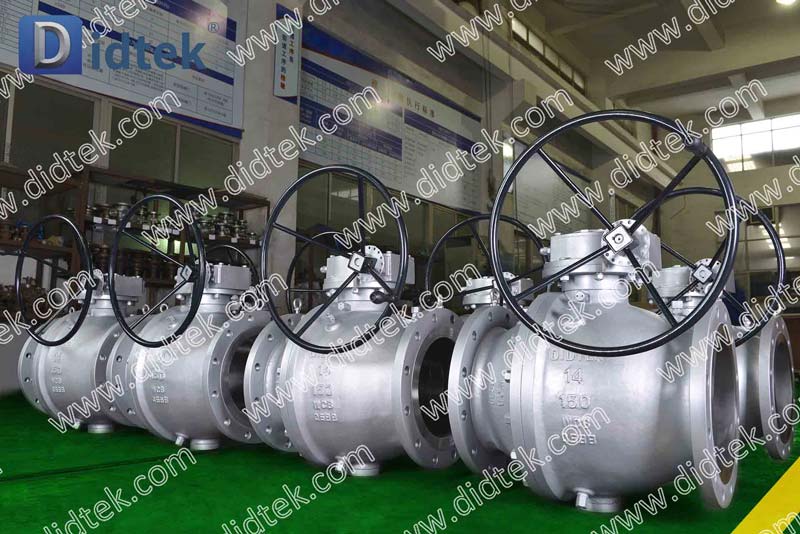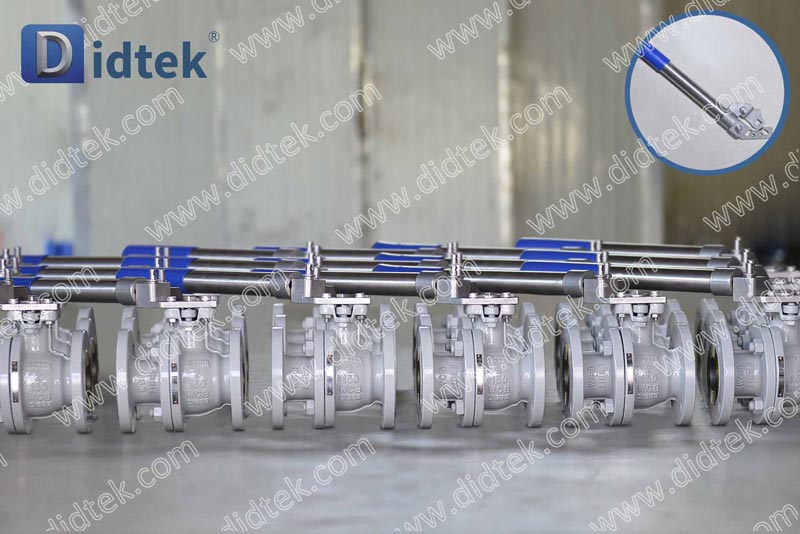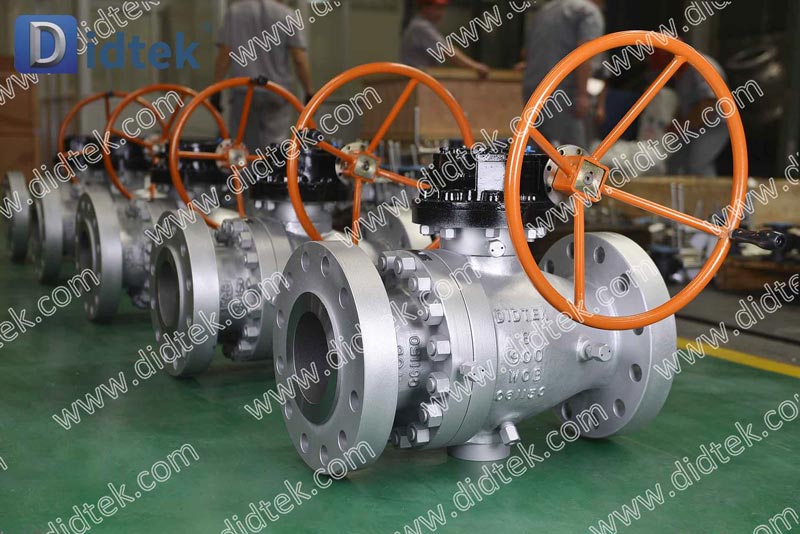These valves control fluid flow through a hollow, rotating ball that can be full bore or reduced bore. Full bore ball valves are sized equal to the inside diameter of the adjacent pipe. Reduced port (standard port) valve diameters are dimensioned one pipe size smaller than the internal dimension of the adjacent pipe. For example, a 1” reduced bore ball valve will actually use a 3/4” diameter ball.
Ball valves have several advantages over other industrial valves, most notably:
• They provide a leak-proof seal.
• They can be opened and closed quickly.
• They outlast most other industrial valves.
There are several ways to classify valves. Each category or design determines the performance characteristics of the valve. These categories include:
• Valve design based on ball motion: floating and fixed installations
• Port Designs: Full port, standard or V-port valves.
• Body styles: one piece, two piece, top entry, three piece or welded body.

Before selecting a ball valve, engineers must ask several questions. Finding the answers to these questions can guide experts through the challenging valve selection process and help select reliable ball valves that meet your piping system requirements. What are these problems?
1. What kind of medium will flow through the ball valve?
The first question an engineer must address is the type of fluid flowing through the pipe. Is it a liquid, gas or semi-solid (slurry)? Understanding the physical and chemical properties of a fluid helps analyze its behavior as it flows through a valve. Understanding the properties of the working fluid is critical to making decisions about valve material, port design, and valve size. For example, when selecting a gas ball valve, we must consider its performance and reliability when handling flammable gases such as hydrocarbons, liquefied natural gas or chemical vapors.

2. Which drive methods will you use?
Piping designers must specify the type of valve actuation that will complement the flow control operation. Some piping systems require frequent valve operations and high levels of precision. Other flow operations require a one-time activation of the ball valve. When selecting a ball valve, designers need to quantify how often the valve will operate. They also need to assess the energy requirements and complexity of the drive technology.
Available ball valve actuation methods include:
• Pneumatic drive
• electric drive
• manual operation
• Hydraulic drive
Evaluate other actuation options such as spring return or double acting actuators. Learn how accessories such as limit switches or pilot valves can affect valve reliability.
In processes requiring fast cycle times, pneumatic actuation of ball valves seems to be the most suitable choice. Engineers can install manually-operated ball valves at critical pipeline locations to facilitate pipeline isolation for maintenance or inspection. These low cycle valves need to be run several times a year.
3. What is the temperature and pressure rating of the pipeline?
When selecting a ball valve, it is crucial to specify the pressure and temperature conditions of the working fluid and the working environment. The temperature range of the working fluid will change the mechanical strength of the valve. If the temperature fluctuates too much, the valve will experience uneven expansion and contraction, which can cause surface cracking over time.
The ball valve should withstand the pressure of the working fluid. Exceeding design pressure limits will affect seal quality and may cause premature wear. Choose a ball valve with temperature and pressure ratings equal to or higher than the piping ratings.
4. What is the estimated annual cycle?
How often the valve cycles will affect the durability of the ball valve. Engineers should estimate yearly operating cycles to determine the durability of different ball valves in a piping system. Other factors such as maintenance and media wear can affect the reliability of the valve over its lifetime.
Designers should estimate the life expectancy of a ball valve before selecting an actuator. When properly specified, ball valves can withstand tens of thousands of operations without failure. Knowing the cycle requirements, engineers may choose pneumatic valves to ensure better durability and reliability than electric valves.
5. How are you going to use the ball valve?
Although there are different types and brands of ball valves on the market, each ball valve has a certain application field. For example, steel ball valves used in chemical processing facilities may not meet specifications for use in hygienic applications. Ball valves provide closure for piping and can also provide directional control of fluid. When selecting a valve for a particular application, designers should understand:
• Valves are designed to shut off flow.
• Valves switch flow between sources.
• Split flow from one source to two different destinations (for 3-way ball valves).

Industrial applications operate under varying pressure and temperature conditions. Various types of ball valves have strict emission and leakage control requirements. When selecting a ball valve, make sure it meets minimum system requirements and regulatory specifications.
6. What materials are the valves made of?
The type of valve material comes down to the properties of the working fluid. When evaluating valve materials, engineers should verify that:
• Compatibility with service media
• preservative
• cost
The most common materials for ball valves are brass, stainless steel, plastic, monel, inconel, molybdenum, chrome, nickel alloy or copper. Severe service ball valves require stronger and more corrosion-resistant materials such as Monel or Inconel.
When inspecting valve materials, designers should pay attention to the composition of sealing materials. Soft-sealed ball valves can use rubber seals or PTFE seals. For extreme fluid service, ball valves feature metal-to-metal seating.
What testing and quality assurance procedures does your valve supplier use?
When working with suppliers or manufacturers, companies should request information about the testing protocols and quality assurance measures they use. The testing program analyzes the performance of different ball valves, leak and discharge testing, and pressure testing to ensure the valve is safe for the specific application.
Don't buy ball valves as they are the cheapest on the market. Take the extra step of evaluating quality assurance standards and standardized markings on the valve body or packaging. There is no point in buying ball valves in bulk and it will just make them fail after a few duty cycles.
7. What certifications should the valve have?
Applications for ball valves span different industries. In each sector, designated organizations certify products to verify compliance with health and safety regulations. Depending on the type of application, ball valves and their actuators require the following certifications:
- ANSI certifications: Determines the pressure and temperature ratings for pipe flanges.
- NEMA certifications: Sets the standards for the design of electrically actuated ball valves.
- NSF certifications: Provide guidelines for selecting ball valves in food, beverage and drug production facilities.
Ball valves should have certifications relevant to the fluid applications you are running within the facility.
8. What are the maintenance requirements for ball valves?
Ball valves generally do not require extensive maintenance intervention. They have simple flow control mechanisms and are less likely to fail. However, this does not exclude the fact that industrial valves sometimes require maintenance. When selecting a valve, develop an inspection and maintenance schedule. Maintain a lean inventory of repair and replacement parts, such as valve seals and actuator consumables. Manual ball valves may require less maintenance intervention than motorized ball valves.
in conclusion
Selecting ball valves for different industrial applications is not an easy process. This requires careful review of piping specifications, balanced selection of materials of manufacture, and study of different valve industry codes and standards. By answering the above questions, engineers and piping designers can make informed decisions and select reliable ball valves that provide long-term service.





